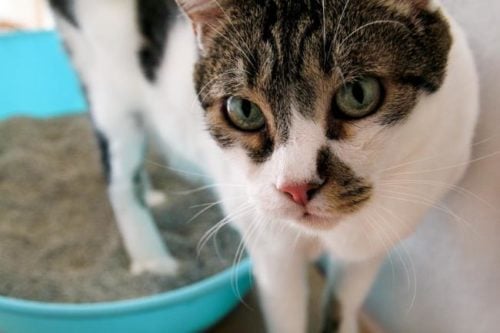A cat not using its litter box is among the most commonly reported cat behavioral problems. The good news is that in most cases the problem is easy to fix.

It is often only necessary to identify and resolve the cause of the problem: additional training or re-training to use the litter box is rarely necessary.
Here are some common reasons that cats avoid their litter boxes:
- Health problems. While health problems are not the top cause of litter box avoidance, they must be mentioned first, as they do cause problems and should be ruled out first. It’s counterproductive to spend time changing the location of your cat’s litter box or training your cat if it’s peeing outside the box because it’s incontinent, for example.
- Untidy litter box. An untidy box is the number one reason for cats not using their litter box. Cats don’t like the smell of urine and feces, and even if the litter box smells fine to you, your cat won’t necesarily agree: a cat’s nose is much more sensitive than yours. Scoop your cat’s box at least daily (or twice daily if your cat has litter box problems already), and empty/refill it completely once a week. You may notice immediate changes in your cat’s behavior. You can find more info about litter box cleaning frequency here.
- Stress. Cats get stressed, which can lead to many behavioral changes, including not using their litter box. The most common causes for stress in cats are environmental changes (moving to a new house, a new bed for a pet, a new pet, new furniture, relocation of the litter box, etc.), changes in routine (time of feeding, time of playing, owner away at an unusual time), and untidy litter boxes (see reason #2).
- Wrong litter type. Cats don’t all love the same kind of litter. Feline preferences vary, though most cats are okay with clumping or non-clumping clay litter. Many cats dislike pine litters and other scented litters, however. If you recently switched to a new type or brand of litter, try switching back. If your cat is scratching the floor around the box it is often an indication of an untidy box.
- Cat not trained to use a litter box. It is easy to train a cat to use a litter box. For kittens, all you need to do is to provide a good box. Sometimes, though, things don’t go so smoothly and a cat misses this important lesson—for example, a cat who goes outside from birth may be hard to train later. Read how to train your cat to use its litter box here.

Is your cat’s box easily accessible? Photo by Deb Collins, cc - Wrong litter box location. There are many ways to get the location of a litter box wrong. In general, the box must be easily accessible and close to places that your cat likes to spend its time. Do not place the box near water or food—while they may tolerate this, cats prefer to keep these activities separate! IMPORTANT: This may apply even when your cat’s box has been in the same place for a long time without any problems. As new factors appear, your cat’s tolerance for a location that is not ideal may decrease, and the location will no longer be tolerated. You can read more about the best litter box locations here. Placing more boxes throughout your house will ensure that at least some of them are right, which leads us to our next point.
- Not enough litter boxes in the house. At a minimum, most feline behaviorists recommend at least one box for every cat in the house, plus an additional box. So that’s three boxes for two cats and eleven boxes for ten cats. They should be placed in different locations throughout the house: one cat may prefer a box in a room where it sleeps, while another may prefer it in the room where she watches the bird feeder through the window. Add different types of litter to different boxes to see which is preferred by your cats.
- Hood on the box. We recommend that you remove the litter box hood, even if it has been on without any trouble so far. The hood traps odors inside the box and may also force your cat into an uncomfortable position, which may become less bearable as the cat ages.
- Your cat is a creature sent from hell to put you through misery. This is the most common reason offered by cat owners when asked why their cat doesn’t use its litter box, but of course it’s not true! Cats are friendly beings who do not do bad things on purpose. They use the toilet that is most convenient to them—if your cat finds some place that is more convenient than its box, check the points above to figure out why.
Now that you’re on your way to understanding why your cat isn’t using its litter box anymore, you’re one step closer to ending its bad habits. The next step is to eliminate whatever is bothering your cat. Our series about cat litter and litter box issues may help you with this.
